Editor’s Note: This text course is an edited transcript of a live seminar. Download supplemental course materials.
Today we are going to be talking about Roger for Adult Solutions. There is also Roger for Pediatrics on the education platform. We will touch on that briefly to give you an understanding of how it contrasts with the options for adults. There are some different receiver and transmitter options for adults versus the pediatric population.
Our objective for today’s session is for you to understand the difference between FM (frequency modulation) and Roger, as well as the situations in which Roger can be beneficial for your patients with hearing loss. I will also describe the difference between Roger Pen and Roger Clip-On Mic.
The current Quest portfolio includes Bolero (Figure 1), which are our behind-the-ear (BTE) hearing aids, and they are Roger compatible. Our custom products are the Virto in-the-ear (ITE) products (Figure 2), and they are Roger compatible. We will talk about the Roger MyLink for products with a T-coil, as well as the Audeo Q (Figure 3), which is also Roger compatible. Our receiver-in-the-ear (RIC) product uses a 312 battery and is compatible only with a ComPilot using a universal receiver. Our power family is the Naida Q (Figure 4). The new pediatric product that we launched this fall is the Sky Q with mix-and-match colors for tone hooks and body cases (Figure 5).
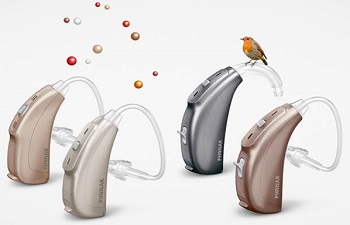
Figure 1. Phonak Bolero Q BTEs.

Figure 2. Phonak Virto Q ITEs.

Figure 3. Phonak Audeo Q.

Figure 4. Phonak Naida Q BTEs and RIC.
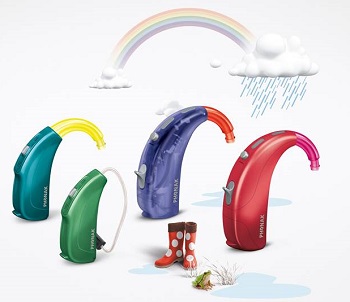
Figure 5. Phonak Sky Q pediatric BTEs.
Phonak has a long history of innovation and improving communication for the hearing impaired, specifically giving access to the spoken word. FM (frequency-moducation) has been around for a long time and has been very beneficial. We released Roger in 2013; it is the new digital wireless standard. It is not Bluetooth; it is not FM. It does broadcast on the same 2.4 GHz frequency range, which we will talk about in just a moment. The name Roger comes from aviation; it means message received and understood. ROGER – Received Order, Given Expected Response. We chose the name for its meaning, as it relates to our goal in hearing technology. We know that speech is powerful and that is why your patients are coming in your doors every day. For those patients who are struggling in noise and have poor discrimination, Roger is a great accessory Roger aims to bridge the understanding gap in noise and distance, and transmits that signal wirelessly directly to the hearing aid user.
What is Roger?
Roger is a new standard that replaces FM. Remember that FM broadcasts on 216 to 217 MHz. Roger operates on 2.4 GHz, which is a specific band called the ISM band that is dedicated to industry, science, and medicine. It is a global band, so Roger can travel all around the world and it is license-free, which is why so many things broadcast on 2.4 GHz, including Bluetooth and Wi-Fi. Baby monitors broadcast here, as well as garage door openers. Roger has a bandwidth up to 7300 Hz. Privacy is guaranteed because of the intelligent adaptive protocol. It has a long range broadcast, does not use a lot of power and has minimal audio delay. We are going to look at all of those things in detail.
Digital Wireless Characteristics
Using a digital wireless system means that the audio signals are sampled and digitized. The receivers and the transmitters (or Roger microphones) are constantly communicating. That signal is packaged and sent back and forth to make sure the message is, in fact, received and understood. It is going to broadcast in any of these different channels from 2.4 GHz all the way to 2.4835 GHz. It is automatically jumping around, and the audio delay is less than 25 msec at about 17 msec. As compared to Bluetooth, our protocol is going back and forth, and is broadcast changing all along those different frequency ranges, whereas Bluetooth stays stationary on whatever channel it is on.
The power consumption is lower with Roger than with a traditional Bluetooth protocol. Bluetooth limits the number of receivers that you can have, whereas Roger can use one microphone with an infinite number of Roger receivers. I can have a classroom full of hearing impaired children, all using the same Roger network, or you can have a husband and wife each using integrated ear-level receivers on their hearing aids all connected to the same Roger microphone. There is a compromise between bandwidth and audio delay. It is possible to get a broader audio signal with Bluetooth, but you do have a much greater audio delay. Conversely, you can have a shorter delay of 5 or 10 msec, but the bandwidth of the audio signal is going to be very narrow. Roger gives us an acceptable compromise of a delay less than 25 msec, which is imperceptible, as well as a broad frequency response.
Frequency Hopping Characteristics
Frequency hopping is an adaptive protocol. The back-and-forth communication between the transmitter and the receiver allows it to establish what frequencies are occupied or free. Because of that, we have privacy. If I was using an FM system and someone else tapped in to the same frequency, they could eavesdrop and hear my conversation. That is not going to happen with Roger, because you have formed your network, and only those microphones and receivers are communicating back and forth. They are searching, hopping over Wi-Fi, other Roger signals, garage door openers, and Bluetooth signals within that 2.4 GHz range.
Who is Roger for, when do we use it, and how does it fit into the rest of our digital wireless accessories? If we are face-to-face in quiet, our hearing aids are going to do the trick. If we get into a noisier environment, such as a restaurant, but are still close and face to face, our directional microphones will kick in. That is going to be helpful and hopefully meet the needs of your patients. When we get into an even louder environment, StereoZoom, which is an advanced directional feature, will engage. We know that hearing aids are sophisticated, but they have their limitations in terms the speech bubble of three to five feet. When the signal has a greater distance to travel between me and the person with whom I want to speak, we start to look at some hearing aid accessories. If the listener is predominantly in quiet environments, the RemoteMic is a great option with our ComPilot. You do have to use the ComPilot and the RemoteMic together for that to work. The microphone in the RemoteMic is omnidirectional. It will definitely pick up the speaker’s voice. However, if you are sitting in a noisy restaurant, the microphone will pick up my voice, as well as all the other noise around me.
Contrast that with Roger, which has directional microphones and a more sophisticated algorithm to evaluate the environment, determine the microphone mode, and to some degree, even clean up the incoming signal. In my mind, anyone who is really struggling in noise, or who has poor discrimination or severe hearing loss, can consider Roger as a great option as well.
Why Roger?
There were a couple of reasons why Phonak decided to create Roger. FM is amazing technology and can drastically improve that signal-to-noise ratio (SNR), and, consequently, communication. With dynamic FM, we can constantly maintain a +10 SNR. Figure 6 shows a graph that compares traditional FM, dynamic FM and Roger. Even with dynamic FM (light gray), hearing-impaired individuals were still struggling in those louder levels of noise. They were getting about 30% to 35% speech understanding. With Roger, the scores jumped up to almost 70%. That is a 54% improvement over traditional FM and almost a 30% improvement over dynamic FM. The scores become even more impressive when the noise level gets to 80 dBA. That is a common environment to be in - any restaurant on a Saturday night, a bar, even some of our classrooms. One of the goals for Roger was to have even better performance in these noisier listening environments.
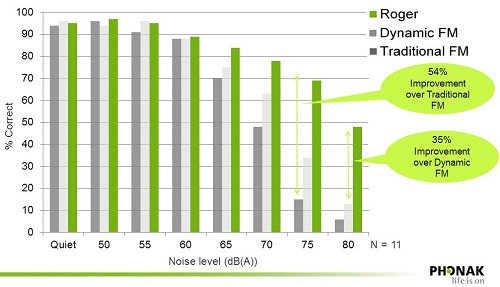
Figure 6. Comparison of speech understanding by percent correct in traditional FM, dynamic FM and Roger (Available at Phonakpro.com).
The second goal of Roger was to offer this technology at a better price point. In my mind, some people would shy away from FM for two major reasons. Number one was the price. It was very expensive. If you were getting two receivers and a transmitter, you were spending more than $3,000. That is a lot for a patient who may have just spent $3,000 - $5,000 for a pair of hearing aids. The second reason is that FM could be a confusing in terms of set up of equipment, channels, avoiding interference and programming. Roger eliminates these obstacles with a better price point for the adult portfolio, simple connection process, and amazing performance in high levels of noise.
Figure 7 shows a picture of Roger. Like FM, Roger needs a receiver and a transmitter, and we are calling these Roger transmitters and microphones. Here in the picture you see the Roger Pen, which is the long, sleek device, and to that right of that is the Roger Clip-on Mic.
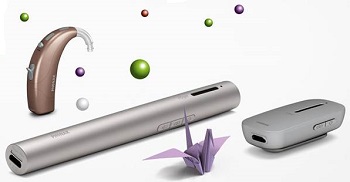
Figure 7. The Roger system for adults, with Bolero BTE, Roger Pen, and Roger Clip-on Mic.
Our goal is great performance in high levels of noise with zero hassle. You are going to make your connection one time and that is all. With FM, you had to re-sync and make sure everything was connected on the right channel. Once you form the network between your Roger microphone and your Roger receiver, you are good to go. You can even power off and back on, and that connection does not terminate. We have universal compatibility with cochlear implants, hearing aids, custom products, RIC products, BTEs, Phonak products as well as other manufacturers’ instruments using one of our universal receivers like the Roger X or the Roger MyLink.
There are different transmitters and receivers for adults versus the pediatric or education population (Figure 8). The Roger microphones are the Roger Pen and the Roger Clip-On Mic. There are three receiver choices. With Phonak products, you have the option of the integrated receivers at ear level, which attach on the very edge of the instruments. It is, essentially, a new battery door. That works for any BTE product that has a size 13 or 675 battery. You cannot do an integrated ear-level receiver with a device that uses a 312 battery, a custom product, or with a non-Phonak hearing aid.
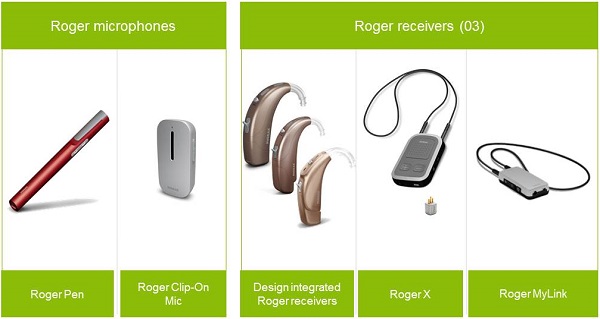
Figure 8. Roger portfolio for adults.
Roger X is the universal mini receiver which can be plugged into a ComPilot, which you see above the receiver in Figure 8. It can also be used with an audio shoe or audio boot similar to an FM boot that can be plugged into any other manufacturers’ device. You can order the audio shoe, or you can lower your cost even further by using one Roger X universal with a ComPilot. It is that same three-plug, Euro-plug design. I was informed recently that Widex has an input to plug that into their streaming device as well. TheRoger X is also compatible with cochlear implants.
The third Roger receiver option is the universal Roger MyLink. This is going to work with any Phonak style hearing aid or other manufacturer’s device with a T-coil. If your cochlear implant has a T-coil, the Roger MyLink will work with that as well, or you can plug the Roger X into the speech processor. As a matter of information, the wireless Roger signal from the Roger microphone, Clip-On Mic or Roger Pen, is sent and received by the Roger MyLink, and then it is sent via the T-coil to the hearing aids. If you use the Roger MyLink, your bandwidth is going to be slightly lower, at close to 5500 Hz compared to the universal integrated receiver at 7300 Hz.
All of these receivers that we are talking about are the 03 receivers for adults; the pediatric receivers are called 02. I just remember that little ears has a littler number.
Roger Pen
Roger Pen comes in three colors: Sterling, Ruby Red, and Petrol (Figure 9). It has a micro USB socket for charging and streaming an audio signal from a phone, computer, or gaming device. That is how you are going to plug it in. There is a mic mode button, a connect button, and the on/off button (Figure 10). Roger Pen also has Bluetooth capabilities for telephone calls. Remember the Roger technology itself is not Bluetooth. That is our adaptive frequency hopping protocol that is on the 2.4 GHz ISM (Industry, Science and Medical) frequency band and within the Roger Pen only; you can also pair it with a Bluetooth phone and use Bluetooth technology for transmission of your phone signal. That is a bonus feature.

Figure 9. Roger Pen in three colors: Petrol, Sterling, and Ruby Red.
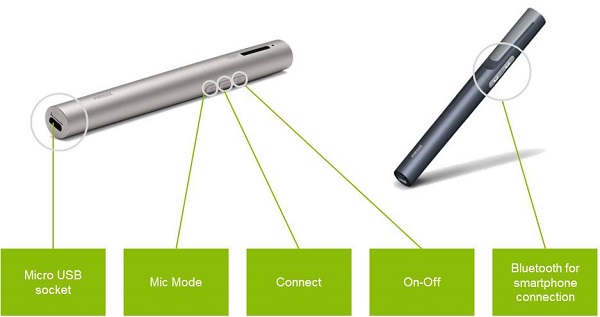
Figure 10. Roger Pen features and controls.
Microphone Modes
There are three microphone modes for Roger: conference, interview, and lanyard. The microphones operate differently based the environment. Conference mode is used when the Roger Pen is flat on a surface, and it has an omnidirectional microphone. The microphones will pick up any voice around the conference table. There is an accelerometer so the microphone knows where it is in space. It knows when it is lying flat and will automatically go into conference mode. In quiet, it is going to be in omnidirectional mode. If the noise level increases above 70 dBA in the meeting because several people are talking, the beam former is automatically activated. At that point, the hearing-impaired person would need to aim or physically point Roger Pen at the primary speaker that they want to hear.
The user could also pick up Roger Pen and use it in interview mode. This is where the hearing-impaired person holds the Roger Pen and points it at the person to whom they are speaking. In a quiet environment, you can easily pick up a voice about 10 feet away. In a noisy environment, you want to have that person be a little bit closer, as it is only going to pick up about three feet. When the user is holding Roger Pen, they want to make sure that they do not cover the microphone. If it is particularly noisy in a restaurant, you can point it at the waiter or waitress when he or she comes up to take your order. If it is a quieter restaurant, just leave it on the table, and you can hear everyone in conference mode.
Lastly is the lanyard microphone mode. This can be worn around the neck, or there is a clip that you use to fasten Roger Pen to your shirt or blouse. Lanyard employs a fixed directional pattern, or a narrow beam, to borrow terminology from FM. We had different zoom settings in our FM systems: Omni, Zoom, and SuperZoom, Lanyard position would be the equivalent of SuperZoom, a very narrow beam former. It needs to be within eight inches of the mouth. There is a voice activity director so that when the person wearing Roger Pen is not speaking, you are not picking up all the clothing noise and other types of noise. This is great for listening to only one person because they are wearing the Roger Pen.
All of this occurs automatically because there is an accelerometer in Roger Pen. This is the same technology used in smartphones where the screen moves based on where the phone is being held in space. It also knows when Roger Pen is dropped or in a free fall. When it hits the ground, you will not hear a loud “kaboom!” in the hearing aids. Additionally, if it is on conference mode and someone bangs the table, you will not hear a loud boom in the hearing aids, either. It is particularly quiet and still has a clean signal when the microphone gets touched (including wind noise) or if clothes are rubbing against it in the lanyard mode.
The microphone modes can be overridden by pressing the microphone mode button on the Roger Pen, but I would suggest leaving it in the automatic mode. There are no delays as you are switching to different modes. It is aware of the environmental noise and the voice of interest. If it is in lanyard mode, it knows where it is in and can automatically engage between omnidirectional and beam former modes. If it gets particularly noisy in conference mode, it will automatically engage the beam former. All of this has adaptive gain to make sure we get that great performance in those high levels of noise. Previous FM systems were limited to +10 dB signal-to-noise ratio (SNR), which is why in those high levels of noise, the FM users began to struggle. Roger has more an adaptive algorithm to give more gain than +10 dB in the high noise environments, which makes it more flexible for the users.
Figure 11 summarizes the three microphone modes of Roger Pen. This is read top to bottom. In conference mode, the position is horizontal. When the noise level is less than 70 dB, it is in omnidirectional mode. When it goes above 70 dB, you have a fixed beam former, which lowers the pick-up distance. In interview mode, you can change from quiet to noisy. The pick-up distance is going to change from 10 feet in quiet down to 3 feet in noise. That is the adaptive beam former changing based on the environment. The lanyard position is vertical. It is always going to stay in that set beam former regardless of the noise level. You want it placed 8 inches from the sound source, which is typically the speaker’s mouth. It uses the same signal processing as Roger Inspiro with an iLapel.
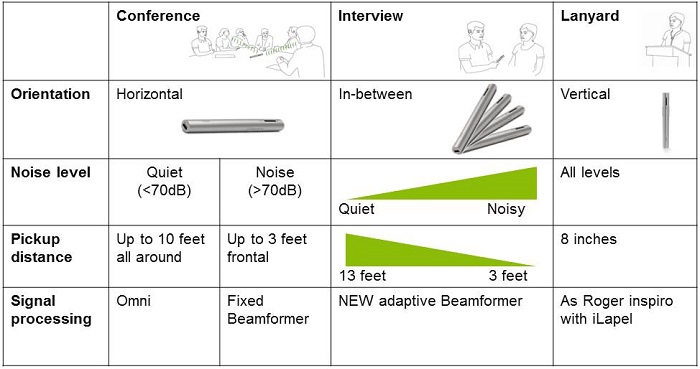
Figure 11. Summary of automatic microphone modes.
Pressing the microphone button will change to a manual microphone mode in a sequential manner. It goes from fully automatic to interview mode, to the conference mode and then to the lanyard mode. It will continue to cycle through in that order if you press the microphone button on Roger Pen.
Bluetooth
Bluetooth technology is available within the Roger Pen only. You can accept or decline calls from a paired Bluetooth phone. You can do last-number redial by pressing the answer call button on the Roger Pen. You can transfer the call back to your phone if you have taken it on Roger Pen. It has a broad audio bandwidth. You can pair up to eight phones, but only can have two phones connected at one time; you cannot switch back and forth. If you are on one phone having a conversation and the second phone that is connected rings, it will go straight to voicemail. It does not support the audio profile A2DP. It is for the Bluetooth headset or handset profiles only. You cannot stream your music from your phone via Bluetooth wirelessly. You can listen to your music using Roger Pen, but that is going to be hardwired. There is an audio cable that ships with Roger Pen that has the micro USB on one end and the universal audio jack/headphone jack on the other. You can hardwire it to listen to music, but only the Bluetooth profile for the phone is currently hands free.
Figure 12 shows the setup to listen to multimedia. It is hardwired via micro USB at the bottom of the Roger Pen to the headphone jack on your phone, mp3 player, computer, or any audio device that has a headphone jack. The microphones on Roger Pen are muted, and it will stay in audio mode the whole time it is plugged in or if you turn Roger off. It can switch from streaming music back to Roger modes very quickly, which is one thing that I demonstrate to my customers. The transition from my computer or cell phone back to Roger is practically instantaneous.
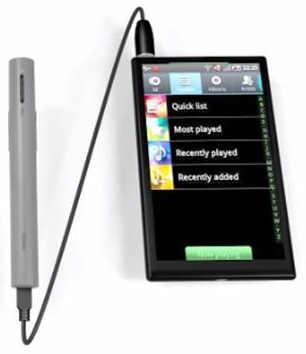
Figure 12. Listening to multimedia in Roger via audio cable.
Roger Clip-on Mic
Our other adult Roger microphone is the Roger Clip-on Mic (Figure 13). It is a less expensive option as compared to Roger Pen. It does not have Bluetooth or a way to override the microphone mode. The Roger Clip-on Mic has a micro USB, so you can also hardwire it to listen to your media files on phones, tablets, mp3 players, or computers. It has a connect button to form your network between microphone and receiver, as well as a power button.

Figure 13. Roger Clip-on microphone in detail.
Because it is clip-on, this Roger microphone is always going to be in the lanyard position for the microphone. It is going to have a fixed beam former and should be placed within 8 inches of the speaker’s mouth. It must be positioned correctly. There is a clip that swivels, so you can clip it horizontally on a button-down shirt, for example, but then still have the microphone faced vertically up at the speaker’s voice. It also comes with the lanyard. You obviously do not want to clip it with the beam former going off to the side, and you do not want to clip it too low because it is not within eight inches of the speaker’s mouth.
Compatibility between Microphones
This feature is if you want to form a multi-talker network, which is another advantage of Roger over FM. You can easily form multi-talker networks with multiple microphones. You can do any mix of Roger Pens and Roger Clip-On Mics, but you cannot form a multi-talker network with Roger Inspiro, DynaMic or the AudioHub here. Those devices here are more for education; there are different products for Roger for Adults versus Roger for Education.
In forming a multi-talker network, if you have a mix of Roger Pens and Roger Clip-on Mics, the Roger Pen must be the primary device. Then you are going to connect the Roger Pen to each one of the other microphones. That is how you are going control your network. If the primary network is not on, the network will not work. You could also form a multi-talker network of all Clip-on Mics, but you have to choose one of those to be designated as the primary to which all the other mics can be connected. If you have ordered a Clip-on Mic, you may have wondered why there are star stickers included in the box. That is to mark which of the microphones is primary if you are forming multi-talker networks.
I used to fit FM when I was in clinic a couple of years ago, and I would get business people who were still active and working. They did not have great word recognition and would go to meetings and conferences, wanting to have multiple microphones so that, based on whoever was talking, they would not miss anything in a meeting. To do that with FM was a challenge. The only way to do that in the past was to give an adult the Inspiro transmitter, which was somewhat big as well, and they would have to form a multi-talker network. They were limited to two microphones because it was designed for team-teaching in a classroom. This obstacle has been overcome again with the Roger technology.
Multi-talker networks are easy to create. However, everyone who has a microphone does need to utilize good conversation skills. There is no priority. Whoever talks first wins, so to speak. It does not matter if I am wearing the primary microphone or one of the other microphones in the multi-talker network; if I am the one talking, my microphone is active. As soon as I pause, and someone else starts talking, they are then active. If I try to interpret and start talking over them, it cannot be done as long as the other person is still actively talking. For most people, that is a normal conversational style. It will not transmit two voices at the same time.
The Roger Clip-on Mic and Roger Pen also come with a docking station (Figure 14). While it is in the docking station, it becomes your TV link. If you have someone who is having difficulty hearing the TV, this is going to be their all-in-one accessory. They do not also have to order a ComPilot and a TV Link. They simply put Roger Pen in the docking station. It is plugged in with a red and white audio cable that plugs into the back of the TV. It broadcasts using Roger technology instead of Bluetooth technology, which is the way ComPilot and TV Link communicate with one another. If you happen to have someone who has a multi-talker network and they are going to have multiple microphones, these docking stations have magnets so that they stick together and line up cleanly on the counter or desk. If the TV gets turned off and they leave Roger sitting there, it is going to power down after 45 seconds.
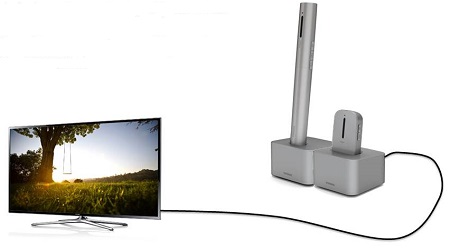
Figure 14. Media setup with docking station for Roger Pen and Roger Clip-on Mic.
Here are your color choices for the Roger Pen. Again these are Sterling, Petrol, and Ruby. Roger Clip-On Mic only comes in that Sterling color.
For a quick recap, we know that the Roger Clip-on Mic is in the lanyard position only needs to be within eight inches of the mouth. If you are in Europe, that would be 20 centimeters. Do not let that question trick you on your quiz. I did want to mention that the Roger system gives you seven hours of listening time. The true universal receiver is the Roger X, as compared to the Roger MyLink which is universal because it works with any T-coil. It is light weight and operates for about seven hours. You can do a multi-talker network of up to 10 microphones. And only the Roger Pen has the Bluetooth connectivity.
Roger Receivers
Roger receivers have full compatibility with hearing instruments, cochlear implants and bone-anchored hearing aids (BAHAs) versus the integrated receivers we spoke about before. That integrated receiver is going to become your battery door. The Roger X receiver can be coupled to a hearing aid via an audio shoe. You also see it plugged into cochlear implant processors, and you can also plug it directly into the ComPilot. The Roger MyLink will work with any manufacturer’s device that has a T-coil.
Figure 15 shows our Roger X. If you are familiar with the MLxi FM receiver, it has the same case. This one is even smaller and compatible with BTEs, cochlear implants, BAHAs, and can be plugged into streamers, the ComPilot or other manufacturers’ streamers. It is automatic. There are no buttons or programming. That was one of the things we upgraded with Roger. You do not have to change the channel the way you did with the FM transmitter and receivers. The operating range in perfect conditions is 66 feet (20 meters), but my experience in the real world with bodies and walls is about 30 or 40 feet.

Figure 15. Roger X universal receiver.
We have a few people on our training team at Phonak who are hearing impaired that have been using Roger for several months. They say the sound quality is amazing, but that once they got past about 30 or 40 feet, they started to get a little bit of intermittency in the signal. If you need to be transmitting over 100 feet, you will want to stick with FM technology. That would be the one advantage FM has over Roger. When you are using Roger, there is no significant power consumption on your hearing aid batteries.
Figure 16 is the Roger MyLink. It can be used with headphones via a headphone jack on the bottom of the device. One is the charging jack, and the other is for headphones. This is a great way to demo Roger in your offices. I have had people who have worn custom hearing aids and put the headphones right over their custom products and listened to Roger. I demo this with headphones on even normal-hearing spouses. They have on the headphones, and I have the Roger Pen. You do get a bit longer operating time with your Roger MyLink because there is a little bit bigger battery compared to the Roger Pen and Clip-on Mic. Roger MyLink has a simple volume control, on/off button, and it charges quickly as well.

Figure 16. Roger MyLink receiver.
The integrated receiver options for cochlear implants for Advanced Bionics, Naida CI, and also for the Cochlear Nucleus products are shown in Figure 17. The Roger 14 integrated receiver must physically connect and make a network. It is very important that your Roger Pen is very close to your Roger receiver - less than four inches. Hit the connect button briefly for one or two seconds and a light will turn green when your connection has been successful. If you get a red light, it means something is off; if you get a longer flashing of the red light, it means it is not compatible. You are trying to connect the wrong receiver to your microphone. As a heads up, the LED light is very small and gives a relatively quick pulse of light. Be ready for it and make sure you are looking right at it.

Figure 17. Design-integrated Roger receivers for cochlear implants.
If you have two ear-level receivers, you will need to hold up Roger Pen next to the ear-level receiver on the right ear, hit the connect button, get the green light, and then go over to the left side, and hit the connect button with it very close. Then you have formed your network. You never have to do that again.
There are other lights that change. Orange indicates a charging battery. When it is completely charged, it turns green. As you change microphone modes, you get a flash of the LED light as well. All of that information is in the user guide which comes with the product, but is always accessible at Phonakpro.com under User Guides, Setup guides, Helpful Tips; there is also a video on how to use Roger.
Figure 18 summarizes the differences between the Roger 02 and 03 receivers. These differences are what account for the pricing discrepancies between adult receivers and the 02 for education receivers. There are some features in those receivers that are accessible only using an Inspiro. 03 receivers only work with the adult transmitters, the Clip-on Mic and Roger Pen. The 02 receivers go either way. They will connect with an Inspiro or with the Roger Pen or Clip-on Mic. It is very simple to order Roger from Phonak. If it is an adult, you are going to order a 03. If it is a pediatric patient and you give us a date of birth, we will automatically send you a 02 receiver.

Figure 18. Differences between the Roger 02 and 03 receivers.
The Digimaster FM system is our sound field system. Those receivers only work with the Inspiro and the Inspiro transmitters. The Roger Inspiro will send both an FM and a Roger signal. That has been great for classrooms that are transitioning over from FM to Roger. It works with the same Inspiro for those children who still have FM receivers.
This last graphic (Figure 19) is an overview that shows what accessory is going to be appropriate for a patient based on the environment in which they will be using it. The ComPilot and RemoteMic are less expensive accessories. It is great for a single partner in lower levels of noise. The ComPilot of supports cellphone use. Remember that Roger Pen has Bluetooth capabilities for cellphones in it. That is going to give you two hours of talk time for Bluetooth calls. If you have a patient who uses their cellphone all day for their job or business or they are very chatty, I would recommend them getting the ComPilot because that is going to give them eight hours of Bluetooth talk time. In that case, if they already have a ComPilot, I would tell them not to pair their Bluetooth phone to the Roger Pen, or if they want Roger and they are at a point to purchase something new, you may do the less expensive Clip-on Mic and ComPilot for the cellphone. Be sure to ask those questions about what will make sense for your patients.
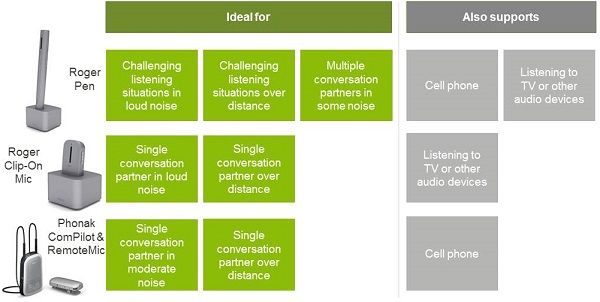
Figure 19. Best-use cases for accessories.
Questions and Answers
How do normal listeners compare at the higher level noise levels?
I do not know. I think that there can be some great variability there. Normal hearing people were not tested for this protocol. This was done for hearing aids, and we have a separate one for cochlear implants. I think there was likely a wide range of performance with normal-hearing listeners, especially if you think about age and processing abilities. I do not have that information.
Cite this content as:
Hebeisen, C. (2014, March). Roger Pen and Roger Clip-on mic: adult solutions. AudiologyOnline, Article 12529. Retrieved from: https://www.audiologyonline.com


